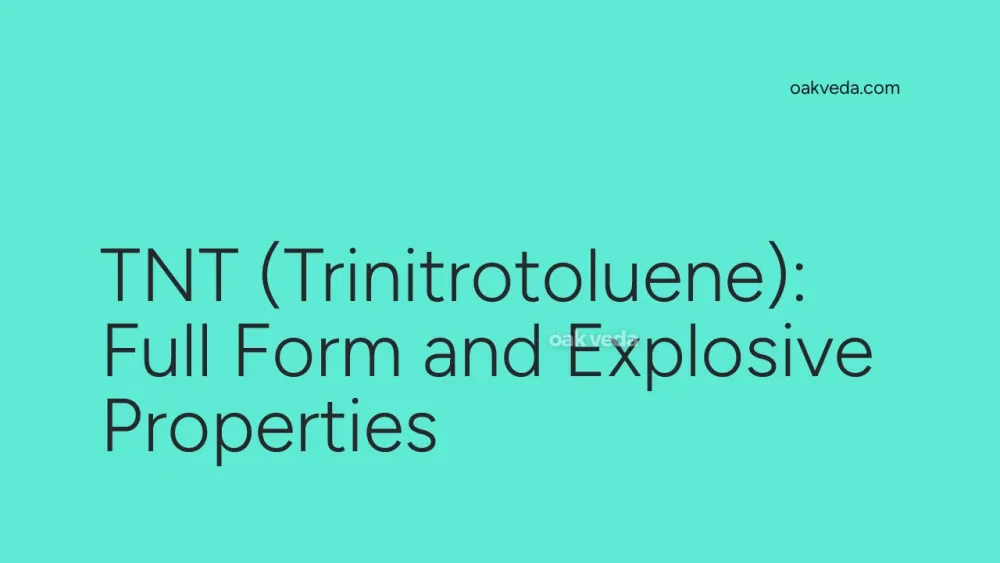
What is the Full Form of TNT?
TNT is the abbreviation for Trinitrotoluene, a powerful explosive compound widely used in military and industrial applications. This yellow, crystalline solid is known for its stability, relatively low sensitivity to impact, and high explosive power.
What is Trinitrotoluene?
Trinitrotoluene, commonly referred to as TNT, is an organic compound with the chemical formula C6H2(NO2)3CH3. It belongs to the class of nitroaromatic explosives and is characterized by its pale yellow appearance and distinctive sweet odor. TNT's explosive properties stem from its ability to rapidly convert from a solid state to hot expanding gases, releasing a tremendous amount of energy in the process.
Origin and Development of Trinitrotoluene
The history of TNT dates back to the 19th century:
- 1863: German chemist Julius Wilbrand first synthesized TNT, initially using it as a yellow dye.
- 1891: Another German chemist, Carl Häussermann, recognized TNT's explosive potential.
- 1902: The German Army introduced TNT as a filling for artillery shells.
- 1907: The British Army adopted TNT, replacing lyddite in their explosive shells.
Since its discovery, TNT has played a significant role in both military and civilian applications due to its stability and predictable detonation characteristics.
How does Trinitrotoluene work?
TNT's explosive power lies in its molecular structure and chemical properties:
- Rapid decomposition: When detonated, TNT quickly breaks down into its constituent elements.
- Gas expansion: The decomposition produces a large volume of hot gases, primarily nitrogen and carbon oxides.
- Shockwave generation: The rapid expansion of gases creates a powerful shockwave.
- Energy release: The reaction releases a significant amount of energy in the form of heat and kinetic energy.
During detonation, approximately two moles of solid TNT transform into about 15 moles of hot gas, accompanied by carbon powder, which contributes to the explosive characteristics.
Types of Trinitrotoluene
While TNT itself is a specific compound, it is often used in combination with other explosives to create more powerful or specialized formulations:
- Pure TNT: Used in its standard form for various applications.
- Amatol: A mixture of TNT and ammonium nitrate.
- Tritonal: A blend of TNT and aluminum powder.
- Composition B: A mixture of TNT and RDX (cyclotrimethylenetrinitramine).
These combinations allow for tailored explosive properties to suit different requirements in military and industrial applications.
Functions of Trinitrotoluene
TNT serves several key functions in both military and civilian sectors:
- Military ordnance: Used in shells, bombs, and other explosive devices.
- Demolition: Employed in controlled demolitions of buildings and structures.
- Mining: Utilized in the extraction of minerals and creation of tunnels.
- Seismic exploration: Applied in geological surveys for oil and gas exploration.
- Chemical synthesis: Serves as a reagent in certain chemical reactions.
Applications of Trinitrotoluene
The versatility of TNT has led to its widespread use in various fields:
- Military operations: TNT remains a crucial component in many types of ammunition and explosives.
- Construction: Used in demolition projects and excavation of hard rock formations.
- Mining industry: Facilitates the extraction of minerals and creation of mine shafts.
- Seismology: Helps generate seismic waves for studying Earth's structure.
- Chemical industry: Employed as a reagent in specific chemical synthesis processes.
Features of Trinitrotoluene
TNT possesses several unique characteristics that make it a preferred explosive:
- Stability: Relatively stable under normal conditions, reducing accidental detonation risks.
- Low sensitivity: Less sensitive to shock and friction compared to other explosives.
- High explosive power: Delivers a strong blast effect upon detonation.
- Meltable: Can be melted and poured into shells or other containers.
- Water-resistant: Maintains its explosive properties even when wet.
- Predictable performance: Consistent and reliable detonation characteristics.
Benefits of Trinitrotoluene
The advantages of TNT include:
- Safety in handling: Lower risk of accidental detonation during transport and storage.
- Versatility: Suitable for a wide range of applications.
- Cost-effectiveness: Relatively inexpensive to produce in large quantities.
- Compatibility: Can be mixed with other explosives to enhance performance.
- Long shelf life: Remains stable for extended periods when properly stored.
Limitations or Challenges of Trinitrotoluene
Despite its benefits, TNT also has some drawbacks:
- Environmental concerns: Can contaminate soil and water if not properly disposed of.
- Health risks: Prolonged exposure may lead to health issues such as anemia and liver damage.
- Sensitivity to extreme heat: Can detonate if exposed to very high temperatures.
- Legal restrictions: Heavily regulated due to its potential for misuse.
- Lower power: Less powerful than some modern explosives, requiring larger quantities for equivalent effects.
Future Developments in Trinitrotoluene Technology
While TNT remains widely used, ongoing research focuses on:
- Safer alternatives: Developing explosives with similar properties but reduced environmental impact.
- Enhanced formulations: Creating new mixtures to improve performance and safety.
- Eco-friendly disposal: Innovating methods for safe and environmentally responsible TNT disposal.
- Detection technologies: Improving techniques for identifying trace amounts of TNT in security applications.
FAQs on TNT Full Form
-
What is the chemical formula of TNT? The chemical formula of TNT is C6H2(NO2)3CH3.
-
Is TNT the same as dynamite? No, TNT and dynamite are different explosives. Dynamite typically contains nitroglycerin, while TNT is a specific compound (trinitrotoluene).
-
Why is TNT used as a standard measure for explosives? TNT is used as a standard due to its consistent performance and well-understood explosive properties.
-
Can TNT explode if set on fire? TNT typically burns rather than explodes when set on fire. It requires a detonator or significant impact to explode.
-
Is TNT still used in modern warfare? Yes, TNT is still used in various military applications, often in combination with other explosives.
Understanding the full form of TNT – Trinitrotoluene – and its properties is crucial for appreciating its significant role in both military and civilian applications. As research continues, we may see new developments that build upon TNT's established capabilities while addressing its limitations.
You may be interested in:

